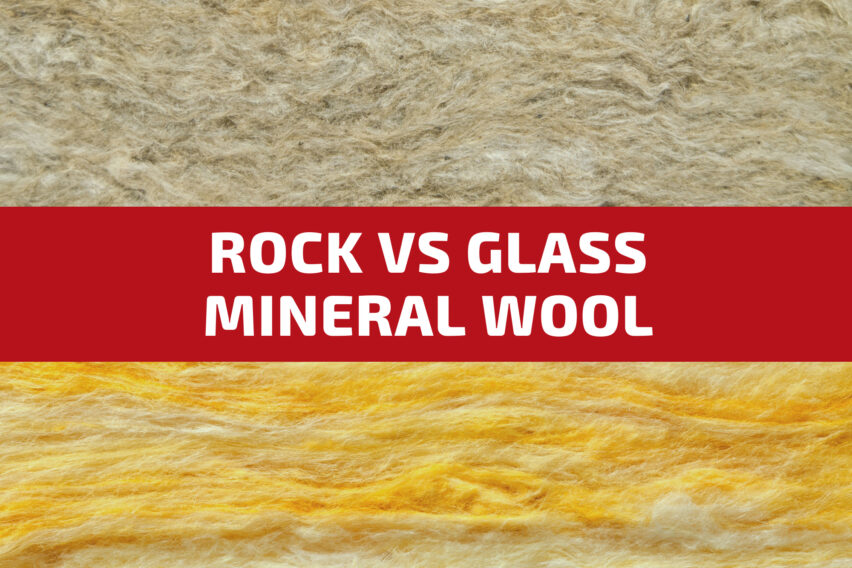
Mineral wool is a catch-all term that can be used to describe two different forms of material: glass mineral wool and rock mineral wool. Both rock mineral wool and glass mineral wool can be produced in a variety of densities, making both options versatile and suitable for a wide range of building applications.
Whilst inherently similar, the two materials are different. In this article, we are exploring the differences between the two.
 Rock Mineral Wool (also known as Stone Wool) |
 Glass Mineral Wool (also known as Fibreglass) |
Depending on how it is produced, rock mineral wool can be a highly sustainable material. In fact, some rock mineral wool solutions include nearly a quarter of secondary industrial waste. Additionally, rock mineral wool has great heat saving properties and can be used to help improve the energy efficiency of homes.
Increasingly, recycled glass is used in the manufacture of glass mineral wool insulation. Glass mineral wool can theoretically be reused and recycled at the end of its life. However, it is worth noting that it’s harder to do this within the UK as there are currently no ‘take back’ schemes available for the material.
Rock mineral wool systems tend to be very easy to install. Whilst slightly heavier than glass mineral wool, rock mineral wool is easier to cut, move and fit into place. In fact, many rock mineral wool systems can be cut using basic construction tools and correctly fitted without the need for specialist equipment.
Glass mineral wool is lighter than rock mineral wool because it is less dense, this makes glass mineral wool limper and very flexible. Rock mineral wool is denser and more rigid. Depending on the application, one may be easier to install than the other.

| Heat Loss:
Rock mineral wool systems can attain R-values of around 3 to 3.3 Glass mineral wool can achieve R-values of around 2.2 to 2.7, which is effective, but not as good as the values of rock mineral wool. |
|
| Sound Insulation:
Rock mineral wool is a dense material, offering tremendous thermal and acoustic properties. As a dense material, rock mineral wool provides exceptional protection against excess noise and as such, can be used to insulate properties against sound just as effectively. Solutions manufactured from glass mineral wool offer solid thermal and acoustic properties but are outperformed by rock mineral wool alternatives. Likewise, as a less dense material, glass mineral wool also offers inferior performance in terms of sound insulation. |
Despite glass mineral wool and rock mineral wool both being cited as non-combustible, the actual fire resistance of each product varies.
| Melting Temperature | Combustibility | |
| Rock | Over 1000˚c | Euroclass A1 Non-Combustible |
| Glass | Around 400˚c | Euroclass A1 Non-Combustible |
| Melting Temperatures:
According to several mineral wool insulation manufacturers, rock mineral wool has a melting temperature of over 1000°C. It has been well documented that glass mineral wool fibres have been tested to withstand temperatures of around 400°C. |
|
| Combustibility & Meeting Standards:
Many insulation solutions manufactured from glass mineral wool will meet the highest standards covered under BS EN 13501-1. However, it is important to check this as and when glass mineral wool insulation is chosen for a project, to ensure it does comply to this standard. Products made from glass mineral wool are also able to meet the best possible Euroclass ‘A1’ standard for reaction to fire classification. Although glass mineral wool can be incorporated within a fire-stopping system, helping to meet increasingly stringent fire-related regulations – it doesn’t match rock mineral wool insulation in terms of fire-resistant performance. |
Our final thoughts:
Whilst both materials offer strong performance, rock mineral wool is the superior option, as across almost every aspect of performance, the material delivers greater results. Most notably, rock mineral wool delivers far more effective performance regarding fire resistance. Due to rock mineral wool’s high melting point, this exceptional performance dramatically mitigates the risk of fire spreading within building structures. That’s why at ARC, we use the material across our range of cavity fire barrier and cavity closer solutions.
Last updated on 01/04/2022
Read our full Whitepaper for more detailed information: